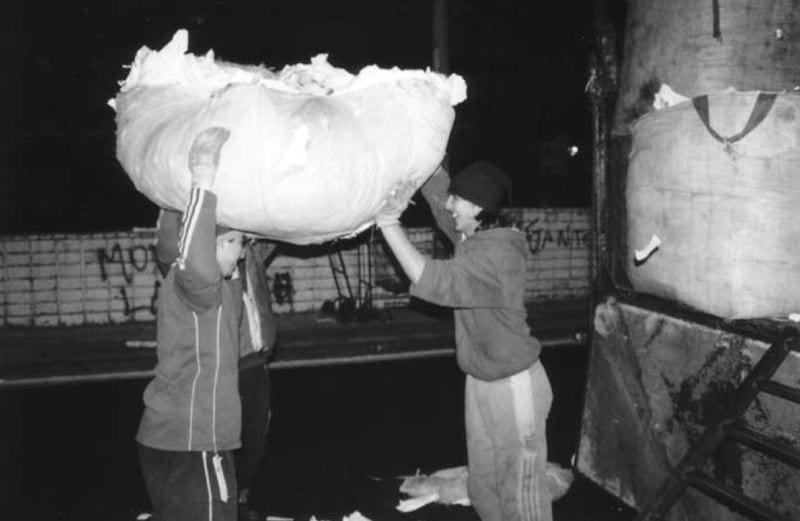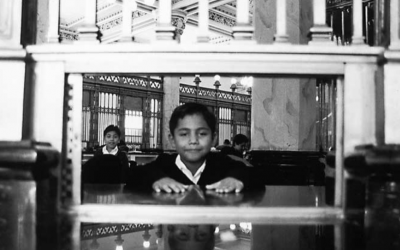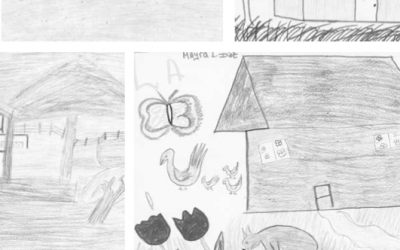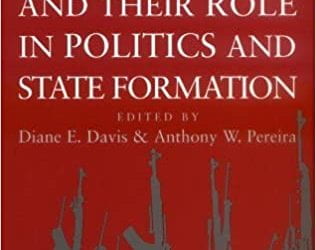Child Labor in Argentina
Scars of Poverty

Cartoneros unload their sorted paper products. Photo by Christopher Smallwood
A tiny boy no more than eight years old walks along ranks of stopped cars at Plaza Libertad in Buenos Aires. Face and hands dirty, hair disheveled, he asks for spare change. One window lowers, a hand stretches out to drop the requested gift into the boy’s palm. The light changes. The cars drive on.
Several blocks away, newspaper interns and business executives lunch at El Inmigrante, a no-frills restaurant on Azopardo where you can order a sizzling steak and watch a soccer game or the latest political developments on television. Children make the rounds here, too, visiting the various tables, selling pens, stickers, bookmarks. Dos por un peso. It is almost impossible to spend an entire lunch break without having to play through the scenario at least once.
Nightfall brings an end to the restaurant and street-begging operations, but as they say, this is a city that never sleeps. Between 1 and 4:30 a.m., eight blocks to the west, a truck manned by four teenagers, Luis, Carlos, Luis Alvarez, and Cristián, becomes the destination for dozens of cartoneros. The collectors busily trudge in with shopping carts and burlap bags of full of sorted paper products extracted from the city’s garbage cans. About one in ten of those who emerge from the shadows is not more than four feet tall.
The story repeats, over and over again, across literally thousands of other intersections, restaurants, cafés, subway stations, alleys. Children juggle, wash windows, sell cheap batteries, vend tissues, bicker and beg outside grocery stores, tag along with their parents collecting garbage.
Child labor in Argentina is largely informal. By law, the practice is banned. There are no children’s sweatshops, no factories where children manufacture footballs or sort through used syringes. There are, particularly in the Argentine countryside, a number of areas where exploitation of children is just as grave. Child prostitution, declared by the International Labour Organization (ILO) in 1999 to be one of “the worst forms of child labor,” has been found to be a real problem in northeastern Argentina. In addition, children who work in occupations like tobacco fields in the northwest face serious dangers. With their smaller height, they are forced into more direct contact with harmful pesticides than their adult counterparts.
However, the vast majority of child workers are the beggars and jugglers and garbage collectors—more than a million of them—who toil right in and around urban areas like Buenos Aires.
The UN’s International Labor Organization (ILO) estimates some 1.5 million children are working in Argentina. That’s six times as many as 1995, when the United Nations Children’s Fund (UNICEF) estimated 252,000 child workers. The new statistics come with a particular sting, considering the country by many other indicators has a lot of potential for development comparable to the United States or Europe. Argentina boasts a 97.1 percent literacy rate, and holds a vast abundance of natural resources.
Argentina’s political and monetary crisis in December of 2001 and the subsequent 2002 peso devaluation contributed heavily to child labor. However, as early as August 2000 the National Ministry of Labor, Employment, and Social Security had already seen enough need in the area to launch the National Commission for the Eradication of Child Labor (CONAETI). Movicom BellSouth launched a private program of its own, Proñino, in November 2000. The Confederation of Educational Workers of the Republic of Argentina (CTERA) even goes so far as to place the blame clear back in 1976, with the implementation of “neoliberal socio-economic programs” by the last military dictatorship.
Whatever the causes, however, the effects are clear. In the last few years, drastic numbers of youth and children are working full time in addition to attending school, or are abandoning school altogether.
Children who work suffer from fatigue, and consequently an inability to perform well in school. Carolina Abrales, former gradeschool teacher and current CTERA administrator, put it quite bluntly: “A child that works will never learn as well as the child that only comes to school and then goes home.” Solutions are equally complicated, but there seems to be hope at least, with a host of organizations and programs working to reverse the situation. UNICEF evaluates, “As a paradoxical consequence of the financial crisis in Argentina, public opinion and civil society organizations have became more aware of children, especially the poorest among them.” According to UNICEF, government social programs receive a combined annual budget of 1.23 million dollars. The largest of these programs is the Heads of Household Plan, granting subsidies to unemployed parents.
For the World Day Against Child Labor, June 12, the Ministry of Education in conjunction with UNICEF also launched a program that grants scholarships to children to attend school. CTERA, as well, is making an effort to raise its awareness of child labor, participating in a two-year initiative with the ILO to help teachers become better prepared to deal with the problem.
In the private sector, programs such as Proniño provide scholarships and offer children resources in education, health and activities to fill free time. The program is also trying to change a cultural idea that working to help out parents is good and normal. It seeks to create work opportunities for the parents of at-risk children. Although Proniño is small in scope with only 1590 beneficiaries, only 1.3 percent of children enrolled in the program has dropped out of school, well below the projected average for school dropouts.
With or without programs, somehow the poor of Buenos Aires do go on carrying some version of hope, and even if hope on the rational level is impossible. A street vendor named Walter perhaps put it best. Now 21 or 22, he said that he began working as a four-year-old. Both his parents, and maybe one of his siblings, were dead before he reached his teens. Never having had the chance to complete school, he continues to live on the brink of poverty, selling batteries. But he doesn’t disdain the life he leads, and even appears to be very grateful for it. “I like living, I like working. I like soccer,” he said, faintly smiling at a new ball he had picked up downtown earlier in the afternoon.
Winter 2004, Volume III, Number 2
Christopher Smallwood is a junior in Eliot House, and a 2003 DRCLAS grant recipient. Last summer, he spent two months in Argentina writing for the Buenos Aires Herald.
Related Articles
Editor’s Letter: The Children
A blue whale spurts water joyfully into an Andean sky on my office door. A rainbow glitters among a feast of animals and palm trees. Geometrical lightning tosses tiny houses into the air with the force of a tropical hurricane.
Centroamerica
Cuando Pedro Pirir, fue despedido del taller mecánico donde trabajaba desde hacía muchos años, experimentó una sensación de injusticia y pena que luego se transformó en una voluntad…
Irregular Armed Forces and their Role in Politics and State Formation
As I sat in heavy traffic in the back of a police car during rush hour in the grimy northern zone of Rio de Janeiro, I studied the faces of drivers in neighboring cars, wondering what they thought of…




